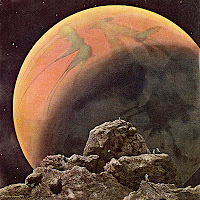An apposite Jot in view of the recent death of Wurzel soundalike, Professor Colin Pillinger, the space scientist behind the Beagle 2 Mars landing vehicle. The British Interplanetary Society was actually founded as long ago as 1934, when H. G. Wells was still alive, and is still going strong. I don’t know if Pillinger was a member, but in 1954 Arthur C. Clarke was on the publications committee and Patrick Moore was sitting on the Council. It is notable that although most of Moore’s fellow Council members had a degree, not one of them achieved anything like as much as this college dropout did in the field of astronomy.

The lead article in this January 1954 issue of the Society’s Journal is a passionate plea by Dr A. V. Cleaver, head of the rocket division at Rolls Royce, for funds to be taken out of Europe’s various military budgets and put into a space programme which would ultimately see a man on the moon, flights to Mars and Venus, and ultimately the establishment of bases on these and other planets. Like many scientists before and since, Cleaver argues that the space race must be seen, not as a huge waste of resources, but as a logical extension of Man’s ceaseless striving to explore, and also a potential opportunity to develop various technological projects.
The writer betrays a political naiveté shared by many scientific visionaries, but his technical knowledge can hardly be faulted. The article ends with some fascinating appendices outlining time scales and costs. Interestingly, although he speculates vaguely on significant progress occurring in 'generations' , he does make some bold predictions. For instance, by 1975 a 'relatively small piloted Earth –satellite- vehicle might take up its orbit'. And perhaps during the 1980s and 90s 'a few expeditions by small ships, carrying human crews of only one or two, might be organised.'
If anything, these predictions were a little conservative. Within just fifteen years of the article appearing, Man had landed on the Moon— in another issue of the Journal, the more cautious Clarke had predicted that this would happen by 1975. [RH]






